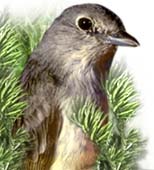|
Colorado Plateau:
A Closer Look At
Gray Vireo
Gray Vireo (Vireo vicinior) is a species of arid piņon-juniper, mountain, and
chaparral habitats. It breeds in the southwestern United States and
northwestern Mexico, with breeding populations extending into western and
southeastern Colorado. Plumbeous Vireos (Vireo plumbeus) are more widespread
than Gray Vireos and breed throughout the Rocky Mountains and Great Basin
ranges. The species breeds in forests of piņon pines and junipers, and in
forests of ponderosa pine (Pinus ponderosa). To a lesser extent, both species
may be found in deciduous trees along streams, but these trees usually lie next
to coniferous forests.
Recent observations suggest that Gray Vireo is not ecologically separated from
other species of vireos during the breeding season. In western Colorado, this
species regularly occupies the same locations as Plumbeous Vireo, but details
of habitat use and interactions were largely unknown. To illuminate this
relationship, RMBO studied the breeding distribution and habitat use of Gray
and Plumbeous at Colorado National Monument, Mesa Co., in western Colorado. We
conducted ground searches and mapped the territories of singing males and pairs
of each in the Monument. We found 160 Gray and 49 Plumbeous vireo territories
in 1999 and 172 Gray and 44 Plumbeous vireo territories in 2000. Following
breeding activities, we measured habitat variables within territories of both
species and within randomly selected vegetation plots. Four variables -
deciduous shrub density, juniper density, juniper height, and piņon height -
discriminated among the three groups. Gray Vireo habitat contained the shortest
trees and highest densities of junipers and deciduous shrubs; Plumbeous Vireo
habitat contained the tallest trees and intermediate densities of junipers and
deciduous shrubs; and random habitat contained intermediate height trees and
the lowest densities of junipers and deciduous shrubs. Our findings were
submitted to the National Park Service in December 2001.
For More Information:
glenn.giroir@rmbo.org
337 25 3/4 Road
Grand Junction, CO 81503
(970) 241-4674
|



